

Famous & Not so Famous Cricketing Incidents
Preamble on the Spirit of Cricket
"Cricket is a game that owes much of its unique appeal to the fact that it should be played not only within its Laws but also within the Spirit of the Game. Any action which is seen to abuse this Spirit causes injury to the game itself."Cricket legends Dennis Lillee and Javed Miandad clash at the WACA Ground in 1981
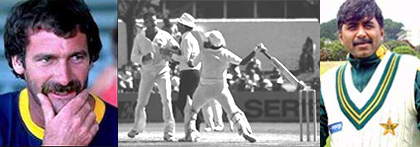
'One of the most undignified incidents in Test history'
Photo 2003 West Australian Newspapers Limited, Buy ItDennis Lillee [external, reference.com] and Javed Miandad were two of cricket's most high-profile players in the 1980s.These two abrasive characters came up against each other when Pakistan toured Australia in 1981-82, with explosive consequences. At Perth, Australia were bowled out for 180 after being put in on a moist pitch, but there was still enough juice to enable Lillee (5 for 18) and Terry Alderman (4 for 36) to rout Pakistan for 62 they were 26 for 8 at one stage. Second time round, Australia piled up 424 for 8, setting Pakistan an almost impossible 543 to win and almost two days to survive.
Miandad turned Lillee behind square for a single, and in completing an easy run, he collided with the bowler. Eyewitnesses agreed that Lillee was to blame and most observed that he had deliberately moved into the batsman's path. According to Lillee, Miandad struck him from behind with his bat. Lillee then turned to confront Miandad, and Miandad lifted his bat above his head as if to strike him. The unedifying images of Tony Crafter, the umpire, stepping in to hold back Lillee while Miandad wielded his bat like a deranged javelin thrower were beamed around the world.
The Australian Board acted, reducing the fine fixed by players from A$200 to A$120 and adding a two-match ban. Cynics noted that the punishment ensured that Lillee missed two fairly low-key one-day internationals, and none of the Tests.
Australia won by 286 runs and lead the 3-Test series 1-0. But Pakistan came back in the third and last test and squared the series.
Md. Azharuddin: The Rise and Fall of a Cricketing Legend
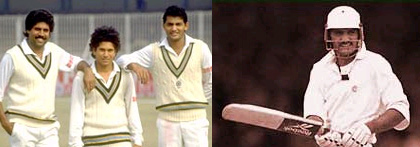
The Most Glorious Entry, Humiliating Exit
Azhar announced himself with a century on his debut, in India's third against England at Calcutta in December 1984. Just in case there were still any doubters that this gangly, buck-toothed 21-year-old possessed a rare - possibly unique - batting genius, he repeated the trick in the fourth Test and then again in the fifth. Even England supporters were spellbound - and they remained so as he amassed 1,278 runs against their team at 58.09, including six centuries, over his career. The first of two hundreds on the 1990 tour was perhaps his most magical - 121 at Lord's at quicker than a run-a-ball in response to Graham Gooch's 333. One of India's most successful captains with 14 wins, all but one at home, in 47 matches, he was however sacked in 1997 and soon after lost his place. Reinstated as player and captain soon after, his final humiliation came when he was banned from cricket for life for his involvement in the match-fixing saga.Don Bradman: Just 4 Runs short for the Perfect 100.00
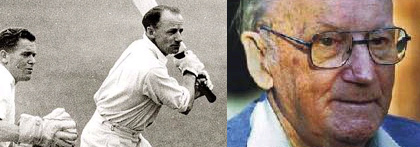
The Highest Average and the Most Famous Duck
Don Bradman (1908 - 2001)In his first international tour, in 1930, Bradman made 2960 runs (with a batting average of 98.66), including 10 centuries. In 1936 Don was made Australian Captain. World War Two interrupted a brilliant cricket career. In his final tour, 18 years after his debut, he made 2428 runs with an 89.92 batting average, including 11 centuries. When Don Bradman played his last test innings at The Oval, he needed just four runs to take his average to 100. He was bowled by Eric Holles for nought off the second ball.
Don retired with a test cricket average of 99.94 in 1948. Don's the only Australian ever knighted for services to the game of cricket.
"I am quite certain he was the best cricketer ever to walk onto a cricket ground in any part of the whole wide world." (Bill O'Reilly - former Test Cricketer)
Sir Donald Bradman died of pneumonia at his home in Adelaide on 25 February 2001. By then he had been elected as the Wisden Cricketer of the Century.
Sachin Tendulkar: The Desert Storm - Back to Back Centuries in Coca-Cola Cup, 1997-1998
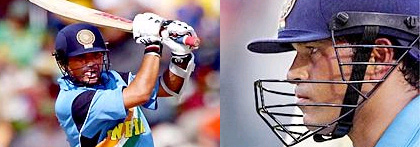
Every time he walks out to bat, he carries the hopes and aspirations of a billion people with him
Sachin Tendulkar's best two ODI centuries came in Sharjah 1998. On 22nd April 1998 India had to beat Australia in the last league match in the Coca-Cola Cup to enter the finals. The Australians, batting first, had piled on an imposing 283. India lost four quick wickets and the required rate rocketed to more than a run a ball in the remaining 20 odd overs. A furious sand-storm hit the stadium stopping play for half an hour. By the time play resumed, the target was readjusted to an even steeper 94 runs in 87 balls. He smashed the very first ball off Michael Kasprowicz for a six and hammered his way to 143. India lost the match by 20 odd runs but Sachin had accomplished his mission: to see India through to the Coca-Cola Cup final for yet another showdown with the Aussies. Two days later at the same venue, in the final against Australia on his 25th Birthday, he gave himself the perfect birthday present with a match-winning, final-clinching century. Just like before, Australia batted first and put up a formidable target of 273. This time, Tendulkar went after the Aussie bowling, ending up with a match-winning 134 (131 balls). While his previous effort was brutality personified, this time Tendulkar batted with scalpel-like precision. Sachin uncorked his trademark power-packed shots only after India was well on the road to victory. India won the trophy beating Australia by 6 wickets. In the tournament, Sachin scored 435 runs at an average of 87.00 in 5 innings and scored 2 centuries. He also won the Man of the Series award. Sir Donald Bradman, the Australian great said of Sachin, "He reminds me of myself". Brian Lara, the West Indian Legend said, "He has the world at his feet and he's taking it one step at a time. He'll play a lot more and I am proud for him as a friend I hope he goes on to even greater things."Greg Chappell: The Underarm Incident
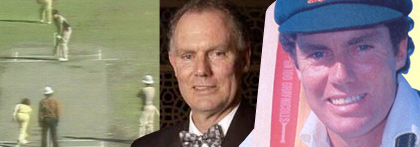
"Well I was disgusted at the time ... but an hour after the game we were just sort of joking about it," McKechnie
Chappell told his brother Trevor to bowl underarm along the ground for the final delivery of a limited-overs international against New Zealand on February 1, 1981. The action prevented tailender Brian McKechnie hitting the six runs required for a tie in the first match of the finals series. Trevor Chappell, a three-Test veteran and the lesser-known younger brother of Australian captains Ian and Greg, said at least it meant he was famous for something. Australian wicketkeeping great Rod Marsh, now head coach at Australia's cricket academy, said the only positive to come from the incident was the rule change outlawing the ploy. After retiring from first-class cricket in 1986, Trevor Chappell played several seasons of Sydney grade cricket with North Sydney and coached the Gordon Women's Cricket Club and was subsequently engaged by Sri Lanka as a fielding coach and had a spell as Bangladesh's national coach.Bodyline Series: The 1932-33 English tour of Australia

The English referred to their new tactic as "Leg Theory'', but the Australians christened it "Bodyline''
The arrival of the English touring side in Australia for the Ashes series during the summer of 1932-3 was much anticipated by all Australian cricket fans. Unknown to the Australians at the time was the fact, English captain Douglas Jardine was about to write his team into the record books for all the wrong reasons. To counter the skill of the great Australian player Donald Bradman, who had devastated the English bowling attack during the 1930 series, Jardine adopted a tactic later to become known as Bodyline.Bodyline involved the placing of a least five players close in to the batsman and the bowler continually bowling a barage of short pitched balls, these balls would quickly rare up from the pitch placing the batsman in danger of serious injury. To counter these rising deliveries, the batsman would be forced to adopt defensive batting strokes, which would regularly result in catches to the close in fieldsmen. Many Australian players were subsequently injured as a result of the tactic of Bodyline. It was not only the Australian players who were aghast at the despicable tactics of the English, but also the Australian cricket authorities. The Australian Cricket Board sent an urgent telegram to its couterpart in England demanding they instruct Jardine to discontinue his methods. The Laws of Cricket were eventually changed to ensure the debacle, which was the Bodyline series was never repeated. The spirit of the game had to be protected at all costsBrian Lara's 400*
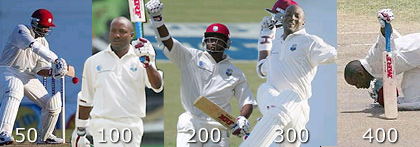
The First Quadruple Century in Test Cricket
Brian Lara set the highest score ever in Test cricket, hitting 400 not out in the fourth Test against England. Lara passed the previous best of 380 by Matthew Hayden and then declared after reaching the quadruple century. The Trinidadian left-hander faced 582 deliveries, hitting 43 fours and four sixes, setting a new mark just over two hours into the third day in Antigua. West Indies 751-5 dec. drew with England 285 & 422-5. The feat came on the same ground where he hit a then record 375, also against England, in 1994. He also holds the record for the highest first-class score, 501 not out for Warwickshire against Durham in the English county Cricket Championship. Brian Lara become the fourth player in Test cricket history to score 10,000 runs during the Windies' second innings on the fourth day of the third Test at Old Trafford vs. England (2004) In Picture: Brian Lara on his way to the glorious 400 not out..United Cricket Board of South Africa and Racial Quota
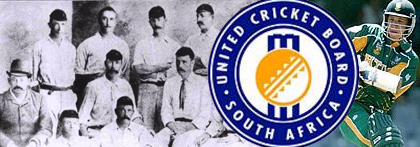
South African Cricket Set to Self-Destruct
The present racial quota policy of the United Cricket Board of South Africa, which requires South African cricket teams to include a minimum number of coloured players is set to cause the sport to self-destruct before it has the opportunity to achieve the purpose for which it was implemented. Under current policy, provincial cricket teams are required to consist of no-less-than, three coloured players and the national team, at least one coloured and one black. Formulated to address the lack of opportunities for coloured players during the apartheid era, whereby, the sport of cricket was seen to be an elitist whites only affair with coloured players denied the opportunity of playing alongside their white counterparts, the present policy looks set to achieve nothing more than introducing a new era of racially based discrimination in South African society, the only difference being, this time it is white players who are being discriminated against because of their skin colour. The national unification process of the associations became a fait accompli when WPCB and WPCU became an integrated organisation on June 25, 1991. SACU and SACB united to establish the United Cricket Board (UCB). In Picture: The 1896 South African Team and the UCB logo.Harbhajan Singh Memorabilia
Singh's Magnificent Hat Trick
Own a piece of Indian Cricket History
 On the 1st Day of the 2nd Test, India versus Australia, in March 2001, at Eden Gardens in Kolkata, Harbhajan Singh achieved what no other Indian cricketer had ever done - he snared a magnificent Hat Trick.
On the 1st Day of the 2nd Test, India versus Australia, in March 2001, at Eden Gardens in Kolkata, Harbhajan Singh achieved what no other Indian cricketer had ever done - he snared a magnificent Hat Trick.
Limited Edition Magnificent photographic collage of the three dismissals with the hat trick at Calcutta capturing photograph in each piece being personally signed by Harbhajan Singh. Each piece .encased in a timber frame with Perspex glazing and is supported by A-Tag microchip authentication technology, and comes complete with a Certificate of Authenticity.
![]()
![]() / Read more / Other cricket memorabilia
/ Read more / Other cricket memorabilia



